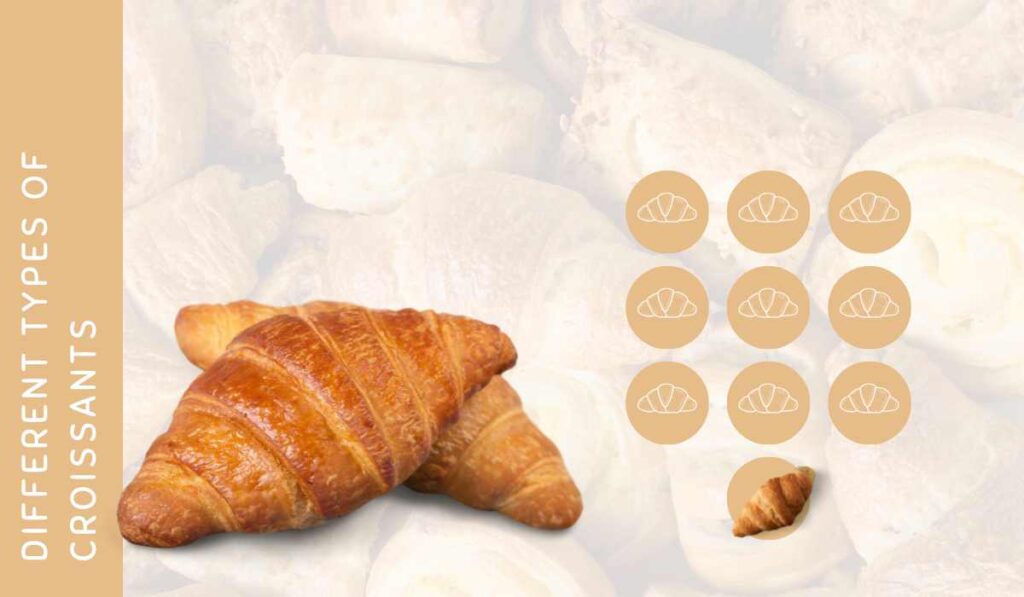To heat up a croissant, preheat your oven to 350°f, then place the croissant on a baking sheet and warm it for 5-10 minutes. Heating a croissant in the oven will help restore its flakiness and ensure a warm, delicious treat.
Croissants are a beloved pastry known for their flaky layers and buttery taste. Whether you have a fresh croissant that needs a touch of warmth or a day-old croissant that could use some reviving, knowing how to heat it up properly can make a significant difference in its taste and texture.
While there are several methods to heat up a croissant, using an oven is often the most effective way to achieve a crispy exterior and a soft, warm interior. We will explore exactly how to heat up a croissant using your oven and provide some additional tips to enhance its flavor. Get ready to enjoy a perfectly heated croissant that will satisfy your taste buds.
The Importance Of Properly Heating Up A Croissant
A croissant is a delectable pastry that is enjoyed around the world for its flaky layers and buttery taste. However, to truly savor the full experience of a croissant, it is essential to properly heat it up. The right temperature not only enhances the flavors but also improves the texture, making it even more enjoyable.
In this section, we will explore the impact of proper heating on the taste and texture of a croissant and why it is essential to fully enjoy its flavors.
The Impact Of Proper Heating On The Taste And Texture Of A Croissant:
- Warm and flaky: When a croissant is heated properly, the layers of buttery pastry become warm and flaky. This makes each bite irresistible as it melts in your mouth, creating a delightful combination of textures.
- Enhanced flavors: Heating a croissant brings out its natural flavors, intensifying the taste of the butter and the delicate sweetness of the pastry. This ensures that every bite is bursting with deliciousness.
- Aromas that tantalize: Heating a croissant releases its enticing aromas, filling your kitchen or café with the irresistible scent of freshly baked pastry. The inviting fragrance heightens the anticipation of enjoying this delightful treat.
Why Heating Is Essential To Fully Enjoy The Flavors Of A Croissant:
- Sensory delight: The warmth of a heated croissant stimulates your senses, enhancing the overall enjoyment of the experience. It creates a pleasurable contrast against the coolness of the butter and spreads, elevating every bite into a sensory delight.
- Melting of fillings: If your croissant is filled with ingredients like chocolate, cheese, or ham, heating it up helps to melt and marry these flavors with the pastry. The result is a harmonious blend of textures and tastes that dance on your palate.
- Timelessness restored: A croissant that has been sitting for a while can lose its freshness. However, heating it up revitalizes the pastry, bringing back the feeling of biting into a freshly baked treat. This allows you to fully appreciate the timeless appeal of a perfectly heated croissant.
So, the next time you find yourself with a croissant in hand, take a moment to heat it up to experience the full potential of its taste and texture. The warm and flaky layers, enhanced flavors, and tantalizing aromas will make you appreciate this classic pastry even more.
The simple act of heating can elevate a croissant from good to extraordinary, ensuring an unforgettable gastronomic experience.
Choosing the Right Croissant

When it comes to heating up a croissant to perfection, your journey begins with selecting the right croissant. The choice of croissant you start with can significantly impact the final result. Here, we’ll delve into the importance of starting with a high-quality croissant and provide tips on where to find or how to make the best croissants for reheating.
The Significance of a High-Quality Croissant
The quality of the croissant you select lays the foundation for a delicious end result. A high-quality croissant typically boasts several key characteristics. First and foremost is freshness. Look for croissants that are freshly baked or frozen shortly after baking. Freshness ensures that the croissant’s flakiness, tenderness, and buttery flavor are at their peak, providing the best canvas for reheating.
Another important factor is the ingredients. Premium croissants are made with high-quality butter and flour, which contribute to their rich flavor and tender texture. They should have a beautiful golden-brown color, a delicate, buttery aroma, and a slightly crisp exterior.
Tips on Where to Find or How to Make the Best Croissants
- Bakeries: Local artisanal bakeries often offer exceptional croissants. Seek out bakeries known for their dedication to quality ingredients and traditional baking methods. Ask for recommendations from friends or use online reviews to find the best bakery in your area.
- Patisseries: Specialty pastry shops or patisseries are also excellent places to find top-notch croissants. These establishments often take great pride in their pastries and are more likely to offer high-quality options.
- Homemade Croissants: If you have baking skills, consider making your own croissants. Homemade croissants allow you to control the quality of ingredients and ensure freshness. There are numerous recipes and tutorials available online to guide you through the process, from making the dough to shaping and baking the croissants.
- Frozen Croissants: In a pinch, you can also find frozen croissants at some supermarkets or specialty food stores. These can be a convenient option, especially if you’re short on time. Just make sure to check the ingredient list and reviews to ensure they meet your quality standards.
Selecting the right croissant is the crucial first step in achieving a perfect reheated croissant. Prioritize freshness and quality ingredients when choosing where to buy or how to make your croissants. Starting with a high-quality croissant sets the stage for a delightful culinary experience when it’s time to heat it up and savor its flaky, buttery goodness.
Additional Tips and Tricks

When it comes to heating up and serving croissants, there are several additional tips and tricks that can elevate your experience from enjoyable to exceptional. In this section, we’ll explore some general tips for enhancing the flavor and presentation of heated croissants, along with suggestions for toppings, spreads, and complimentary beverages that can accompany these delectable pastries.
Enhancing the Flavor and Presentation
To truly savor the glory of a reheated croissant, consider these general tips:
- Butter Brushing: A light brushing of melted butter over the warm croissant can enhance its buttery flavor and add a subtle shine to its surface. This small touch can make a significant difference in both taste and appearance.
- Dusting of Powdered Sugar: For a touch of elegance and sweetness, dust your croissant with a fine layer of powdered sugar. This not only adds visual appeal but also complements the buttery notes of the pastry.
- Sprinkle of Sea Salt: A pinch of flaky sea salt on top of a croissant can create a delightful contrast to its sweetness and enhance the overall flavor profile. It’s a favorite among those who appreciate the interplay of salty and sweet.
- Fresh Herbs: If you’re in the mood for savory croissants, consider adding fresh herbs like parsley, chives, or thyme. These herbs can lend a burst of freshness and earthiness to the buttery pastry.
Toppings, Spreads, and Complementary Beverages
To take your croissant experience to the next level, pair them with suitable toppings, spreads, or beverages:
- Jam and Preserves: Classic fruit jams such as raspberry, apricot, or fig can be spread generously on a warm croissant for a burst of fruity sweetness. These pair beautifully with the pastry’s flaky layers.
- Nut Butter: Nut butters like almond, cashew, or hazelnut spread on a croissant can add richness and a nutty undertone. These spreads pair wonderfully with the buttery base of the croissant.
- Cream Cheese: Cream cheese, whether plain or flavored, is a creamy and tangy option that complements the croissant’s richness. Try it with a drizzle of honey or a sprinkle of cinnamon for extra flair.
- Chocolate or Nutella: For those with a sweet tooth, consider adding a layer of chocolate spread or Nutella. The combination of warm croissant and melty chocolate is a match made in heaven.
- Coffee or Tea: To complete your croissant experience, enjoy it with a freshly brewed cup of coffee or a fragrant tea of your choice. The warmth of these beverages pairs harmoniously with the flakiness of the croissant.
These additional tips and tricks can enhance the overall enjoyment of your heated croissants. Whether you’re aiming to elevate their flavor with simple touches or seeking delightful pairings with toppings, spreads, and beverages, these suggestions can transform your croissant into a culinary masterpiece that tantalizes your taste buds and pleases the eye.
Ways To Heat Up A Croissant
Croissants are a delightful treat that can be enjoyed at any time of the day. Whether you have some leftover croissants or simply want to warm one up for a delectable breakfast, there are multiple ways you can heat up a croissant to perfection.
In this blog post, we will explore three popular methods: traditional oven heating, microwave heating, and toaster oven heating. Each method has its own benefits and techniques that can help you achieve the desired level of crispiness. Let’s dive into the details!
Traditional Oven Heating Method
- Preparing the croissant for oven heating:
- Slice the croissant in half horizontally, creating two separate halves.
- If desired, spread butter or any fillings of your choice on the croissant.
- Place the croissant halves on a baking sheet or a baking dish.
- Setting the correct temperature and time for optimal results:
- Preheat the oven to around 350 degrees Fahrenheit (175 degrees Celsius).
- Once the oven is heated, place the croissant in the middle rack.
- Bake for approximately 5-7 minutes or until the croissant becomes warm and slightly toasted.
- Keep a close eye on the croissant to prevent it from becoming too crispy or burnt.
Microwave Heating Method
- Understanding the limitations of microwave heating:
- Microwaving a croissant may not result in the same level of crispiness as other methods.
- The croissant may turn out softer rather than having a crunchy texture.
- Tips for achieving a crispy texture with a microwave:
- Slice the croissant in half horizontally, similar to the oven heating method.
- Place the croissant halves on a microwave-safe plate.
- Microwave the croissant for about 15-20 seconds on medium heat.
- If the croissant is not warm enough, continue microwaving in short intervals until the desired temperature is reached.
- For a crispier texture, transfer the microwaved croissant to a toaster oven or regular oven for a quick broil.
Toaster Oven Heating Method
- Benefits of using a toaster oven for heating croissants:
- Toaster ovens provide a convenient and efficient way to heat up croissants.
- They have a compact size, making them suitable for small kitchens or limited counter space.
- Adjusting settings to achieve the desired level of crispiness:
- Preheat the toaster oven to around 350 degrees Fahrenheit (175 degrees Celsius).
- Slice the croissant in half horizontally and place the halves directly on the toaster oven rack or on a baking sheet.
- Toast the croissant for approximately 3-5 minutes or until it reaches the desired level of warmth and crispness.
- Keep a close eye on the croissant to prevent it from getting too crispy or burnt.
Now that you know several ways to heat up a croissant, you can choose the method that works best for you. Whether you prefer the traditional oven method for its toasty goodness or the quick convenience of a microwave or toaster oven, heating up a croissant to perfection is just a few steps away.
Enjoy your warm and flaky croissant any time of the day!
Considerations For Different Types Of Croissants

Croissants are a delightful breakfast or snack option, loved by many for their flaky layers and buttery goodness. When it comes to heating up croissants, different types require different considerations to ensure the best flavor, texture, and overall experience. Below, we will explore some tips and techniques for heating up three popular types of croissants: chocolate-filled croissants, almond croissants, and plain butter croissants.
Chocolate-Filled Croissants
Chocolate-filled croissants are an indulgent treat with their gooey and decadent chocolate center. However, heating them can be a delicate task to prevent the chocolate from melting excessively. Here are some tips to consider:
- Preheat your oven to a moderate temperature, around 325°f (163°c), to ensure even heating.
- Place the chocolate-filled croissants on a baking sheet lined with parchment paper.
- Bake them for a short duration, about 5-7 minutes, to warm the croissant without overcooking the chocolate filling.
By following these techniques, you can enjoy a warm and gooey chocolate croissant without ending up with a melted mess.
Almond Croissants
Almond croissants offer a delightful combination of flaky pastry and the nutty flavor of almonds. To enhance their flavor and texture when reheating, consider the following strategies:
- Preheat your oven to a moderate temperature, such as 350°f (177°c).
- Place the almond croissants on a baking sheet and warm them for about 8-10 minutes.
- If desired, sprinkle the croissants with a dusting of powdered sugar before serving to add an extra touch of sweetness.
By following these techniques, you can bring out the deliciousness of the almonds while keeping the croissant’s flakiness intact.
Plain Butter Croissants
Plain butter croissants are a classic choice loved for their simplicity and richness. When reheating them, it is important to preserve their flakiness and buttery goodness. Consider the following tips:
- Preheat your oven to a moderate temperature, such as 375°f (190°c).
- Place the plain butter croissants on a baking sheet and warm them for about 5-6 minutes.
- To maintain the flakiness, avoid overheating the croissants. Keep an eye on them and remove them from the oven as soon as they feel warm to the touch.
Following these techniques will help you savor the delicate layers and buttery taste of plain butter croissants, just like freshly baked ones.
Whether you’re dealing with chocolate-filled, almond, or plain butter croissants, taking these considerations into account will ensure that your reheated croissants taste delightful and retain their unique characteristics. Experiment with these techniques to find the perfect balance of warmth, flavor, and texture for your favorite type of croissant.
Enjoy!
Innovative Heating Techniques
Croissants are delicious treats that can be enjoyed at any time of the day. Whether you’ve bought them fresh from a bakery or have leftovers from the previous day, knowing how to heat them up properly can make all the difference in the taste and texture.
In this section, we will explore three innovative heating techniques that will elevate your croissant experience. Follow along as we uncover the secrets to achieving a crispy exterior, a soft interior, and a unique flavor profile.
Air Fryer Method
The air fryer is a versatile kitchen appliance that can be used to heat up a croissant to perfection. With its ability to circulate hot air evenly, the air fryer ensures that the croissant gets crispy on the outside while remaining soft on the inside.
Here’s how you can utilize an air fryer to achieve optimal results:
- Preheat the air fryer to 350°f (175°c).
- Place the croissant in the air fryer basket, making sure to leave enough space between each piece.
- Cook the croissants for 2-3 minutes, or until they are golden brown and crispy.
- Remove the croissants from the air fryer and let them cool for a minute before serving.
By adjusting the cooking times and temperatures, you can customize the level of crispiness according to your preferences. Experiment with different settings to find the perfect balance that suits your taste.
Panini Press Method
If you’re looking for a unique way to heat up your croissants, the panini press method is worth a try. This technique not only warms the croissant but also creates a pressed and warm delicacy that adds a delightful twist to your culinary experience.
Follow these tips to achieve the best results:
- Preheat the panini press to medium-high heat.
- Split the croissant in half horizontally.
- Place the croissant halves in the panini press, and cut sides down.
- Gently close the press and apply light pressure to flatten the croissant slightly.
- Cook for 1-2 minutes, or until the croissant is warmed through and has a light golden color.
- Remove the croissant from the panini press and serve immediately.
To prevent the croissant from getting too flat or overly crispy, ensure that the pressure applied is gentle and the cooking time is kept short. This method is ideal for those who enjoy a unique texture and a slightly toasted flavor.
Steam Heating Method
Reviving a day-old or stale croissant may seem like a challenge, but with the steam heating method, you can restore its freshness and enjoy it once again. By introducing moisture, this technique ensures a moist and fluffy interior. Here’s how you can use steam to bring life back to your croissant:
- Boil water in a pot or kettle.
- Place the croissant on a heat-safe plate or tray.
- Once the water has boiled, pour it into a shallow dish or a wide bowl.
- Carefully hold the plate or tray with the croissant over the steam for about 15-20 seconds.
- Remove the croissant from the steam, let it sit for a minute to cool slightly, and serve.
The steam will help soften the croissant and make it moist again, resulting in a delightful texture and taste. This method is perfect for those who want to enjoy a freshly baked croissant even after it has lost its original crispness.
Now that you know these innovative heating techniques, you can elevate your croissant experience to new levels. Whether you opt for the air fryer method, the panini press method, or the steam heating method, each technique offers a distinct result that will leave you craving more.
So go ahead and experiment with these methods to enjoy warm, crispy, and delicious croissants anytime you desire.
Troubleshooting Common Issues to Heat Up a Croissant

Reheating croissants can sometimes be a delicate endeavor, and common issues like overcooking or uneven heating can arise. In this section, we’ll address these common problems when reheating croissants and provide valuable solutions and tips to help you avoid these issues and achieve a flawless outcome.
Overcooking Croissants
Overcooking is a common pitfall when reheating croissants, and it can lead to a loss of their signature flakiness and result in a dry, unappetizing texture. To avoid this issue, follow these guidelines:
- Monitor Closely: Keep a watchful eye on your croissants while reheating. Use a timer and check them periodically to prevent overcooking. The precise reheating time may vary depending on your method and the croissant’s size, so stay vigilant.
- Use Lower Heat: When using an oven, consider reducing the temperature slightly. Lower heat over a longer time period can help preserve the croissant’s texture without risking overcooking.
- Wrap in Foil: If you notice your croissant browning too quickly in the oven, loosely cover it with aluminum foil. This can shield the outer layers from excessive heat and prevent overcooking.
Uneven Heating
Another common issue when reheating croissants is uneven heating, where some parts of the croissant are too hot while others remain cold. To achieve even heating, follow these steps:
- Slice in Half: Before reheating, consider slicing your croissant in half horizontally. This allows for more even heat distribution and ensures that both the top and bottom layers heat uniformly.
- Arrange Properly: When using an oven or toaster oven, place the croissant directly on the oven rack or a baking sheet in a single layer. Avoid overcrowding, as this can hinder proper circulation of heat and result in uneven reheating.
- Turn It Over: If you notice that one side of the croissant is heating faster than the other, flip it over halfway through the reheating process. This helps distribute heat more evenly to all parts of the croissant.
Addressing common issues like overcooking and uneven heating when reheating croissants requires attention to detail and proper technique. By closely monitoring the reheating process, adjusting temperatures, and taking steps to ensure even heat distribution, you can avoid these problems and enjoy a perfectly reheated croissant with its delightful flakiness and warm, buttery goodness intact.
Serving And Pairing Suggestions
Enhancing The Decadence Of A Heated Croissant With Various Toppings:
When it comes to heating up a croissant, the possibilities for delicious toppings are endless. Adding the right toppings can take your croissant from delicious to extraordinary. Here are a few suggestions for enhancing the decadence of a heated croissant:
- Butter and jam: The classic combination of rich butter and your favorite jam can elevate the flavor profile of a heated croissant. The butter adds a creamy and smooth texture, while the jam provides a burst of sweetness. Spread a generous amount of butter and top it with a dollop of jam for a simple yet mouthwatering treat.
- Nutella and sliced banana: For those with a sweet tooth, Nutella and sliced banana make a heavenly pairing. Warm up your croissant, spread a generous amount of Nutella, and top it with thin slices of fresh banana. The smooth and indulgent Nutella pairs perfectly with the natural sweetness and slight tang of the banana, creating a delightful harmony of flavors.
- Ham and cheese: If you prefer savory toppings, try a classic combination like ham and cheese to complement your heated croissant. Layer thin slices of your favorite ham and a slice of cheese on top of the croissant and heat it until the cheese melts and becomes gooey. The salty and savory ham pairs harmoniously with the creamy and melted cheese, creating a delicious balance of flavors.
- Smoked salmon and cream cheese: For a more sophisticated twist, top your heated croissant with smoked salmon and cream cheese. Spread a layer of cream cheese on the croissant and top it with thinly sliced smoked salmon. The rich and creamy cream cheese provides a smooth and tangy base, while the smoky flavor of the salmon adds depth and complexity to each bite.
Recommended Beverages To Complement And Elevate The Croissant Experience:
Pairing the right beverage with your heated croissant can enhance the overall experience and bring out the flavors in different ways. Here are some recommended beverages to complement and elevate your croissant enjoyment:
- Coffee: A no-brainer for many, a cup of freshly brewed coffee is a classic choice to accompany a croissant. The rich and aromatic flavors of coffee provide a nice contrast to the buttery and flaky croissant. Whether you prefer black coffee or a creamy latte, sipping on a warm cup of java while enjoying your croissant can be a delightful way to start your day.
- Tea: If you’re not a coffee lover, tea offers a versatile and refreshing option. Choose from a wide variety of teas such as Earl Grey, English breakfast, or green tea to find your perfect match. The subtle and delicate flavors of tea can complement the buttery croissant without overpowering it, creating a harmonious pairing of flavors.
- Orange juice: For a touch of citrusy brightness, a glass of freshly squeezed orange juice can be a great option. The refreshing and tart flavors of orange juice can cut through the richness of the croissant, providing a pleasant contrast. The combination of a warm croissant and a cool glass of orange juice is a refreshing way to start your morning.
- Champagne: If you’re in a celebratory mood or want to indulge in an extra-special treat, pairing your croissant with a glass of champagne can elevate the experience. The effervescence and crispness of champagne can complement the buttery croissant, creating a luxurious combination that feels truly decadent. Choose a dry champagne or a sparkling wine for a sophisticated pairing.
These serving and pairing suggestions are just a starting point. Feel free to experiment with different toppings and beverages to create your own perfect croissant experience. Enjoy!
Additional Resources for Learning How to Heat Up a Croissant?

For those eager to delve deeper into the art of baking and pastry techniques, there is a wealth of educational materials available that can help you expand your culinary knowledge and skills. In this section, we’ll recommend books, videos, and other valuable sources where readers can explore the world of baking and pastry in greater depth.
1. Books
- “The Professional Pastry Chef: Fundamentals of Baking and Pastry” by Bo Friberg: This comprehensive book is considered a cornerstone in the world of pastry education. It covers a wide range of topics, from fundamental techniques to advanced pastry creations. Whether you’re a novice or an experienced baker, this book is a valuable resource.
- “Bouchon Bakery” by Thomas Keller and Sebastien Rouxel: Renowned chef Thomas Keller and pastry chef Sebastien Rouxel share their expertise in this beautifully crafted book. It’s filled with detailed recipes and step-by-step instructions for creating delectable pastries, including croissants, that rival those of professional bakeries.
- “Flour Water Salt Yeast: The Fundamentals of Artisan Bread and Pizza” by Ken Forkish: While primarily focused on bread, this book provides a thorough understanding of the principles of working with dough, fermentation, and the science behind baking. These principles are highly applicable to pastry as well.
2. Online Video Courses
- MasterClass: MasterClass offers a diverse range of cooking and baking courses taught by world-renowned chefs and experts. For pastry enthusiasts, classes by chefs like Dominique Ansel and Christina Tosi provide valuable insights into croissants and other pastries.
- YouTube Channels: Several YouTube channels are dedicated to baking and pastry techniques. Channels like “Preppy Kitchen” and “Tasty” offer step-by-step tutorials, tips, and creative ideas for pastry enthusiasts of all levels.
3. Cooking Schools and Workshops
- Local Cooking Schools: Many cities offer cooking schools or culinary institutes that provide hands-on classes in baking and pastry. These classes often cover a wide range of topics, from basic techniques to advanced pastry artistry.
- Online Workshops: In the digital age, online workshops and courses have become increasingly popular. Websites like Craftsy (now Bluprint) and Udemy offer a variety of baking and pastry courses that you can take from the comfort of your home.
Whether you prefer traditional books, online video courses, or hands-on workshops, these resources offer a multitude of opportunities to deepen your understanding of baking and pastry techniques. Remember that practice and experimentation are key to mastering the art of pastry, so don’t hesitate to roll up your sleeves and embark on your culinary journey.
Frequently Asked Questions On How To Heat Up A Croissant?
How Do You Heat Up A Croissant?
To heat up a croissant, preheat your oven to 350 degrees Fahrenheit. Place the croissant on a baking sheet and warm it for about 5-7 minutes or until it becomes crispy and golden. You can also use a microwave oven to heat the croissant for about 15-20 seconds.
Can You Microwave A Croissant?
Yes, you can microwave a croissant. Simply place the croissant on a microwave-safe plate and heat it for about 15-20 seconds. Be careful not to overheat it, as it may become soggy. If you prefer a crispy croissant, the oven method is recommended.
How Do You Keep A Croissant Crispy?
To keep a croissant crispy, store it in an airtight container or wrap it tightly in foil. Avoid leaving it at room temperature for too long, as it can become stale and lose its crispness. If the croissant has already become soft, you can reheat it in the oven or toaster oven to restore its crispiness.
Can You Freeze Croissants?
Yes, you can freeze croissants. Wrap each croissant tightly in plastic wrap or place them in a sealed freezer bag. To thaw, leave the croissant at room temperature for about 1-2 hours. To reheat, follow the heating instructions provided earlier.
Frozen croissants can be stored for up to 2 months.
Conclusion
Croissants are a beloved pastry that can be enjoyed at any time of the day. Whether you’re having it for breakfast, as a snack, or even as a dessert, knowing how to properly heat up a croissant can make all the difference.
By following a few simple steps, you can transform a cold and stiff croissant into a warm and flaky treat. First, decide on the heating method that suits your preferences and available appliances. Then, prepare the croissant by slicing it in half.
To achieve the perfect level of warmth and crispness, consider preheating your oven or using a toaster oven. Avoid overheating by keeping a close eye on the croissant as it heats. Lastly, remember to enjoy your warm croissant with your favorite beverage or accompaniments.
Whether you prefer a simple buttery flavor or want to add some sweetness with jam or chocolate spread, the possibilities are endless. By following these simple guidelines, you can elevate your croissant experience to a whole new level. So, next time you’re craving a warm, flaky treat, don’t hesitate to heat up your croissant using these techniques.








One Response
Wow, wonderful weblog layout! How long have you ever been blogging for?
you make blogging look easy. The whole look of your site is fantastic, let
alone the content! You can see similar here sklep internetowy